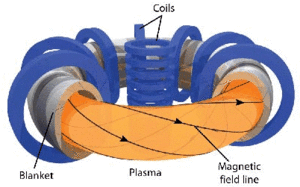Nuclear mattersResearch shows promise for nuclear fusion test reactors
Fusion powers the stars and could lead to a limitless supply of clean energy. A fusion power plant would produce ten times more energy than a conventional nuclear fission reactor, and because the deuterium fuel is contained in seawater, a fusion reactor’s fuel supply would be virtually inexhaustible

Lithiated graphite plays its cruscial role where the superhot plasma meets its physical container // Source: fyysika.ee
Researchers have discovered mechanisms critical to interactions between hot plasma and surfaces facing the plasma inside a thermonuclear fusion reactor, part of work aimed at developing coatings capable of withstanding the grueling conditions inside the reactors.
Fusion powers the stars and could lead to a limitless supply of clean energy. A fusion power plant would produce ten times more energy than a conventional nuclear fission reactor, and because the deuterium fuel is contained in seawater, a fusion reactor’s fuel supply would be virtually inexhaustible.
Research at Purdue University focuses on the “plasma-material interface,” a crucial region where the inner lining of a fusion reactor comes into contact with the extreme heat of the plasma. Nuclear and materials engineers are harnessing nanotechnology to define tiny features in the coating in work aimed at creating new “plasma-facing” materials tolerant to radiation damage, said Jean Paul Allain, an assistant professor of nuclear engineering.
One lining being considered uses lithium, which is applied to the inner graphite wall of the reactor and diffuses into the graphite, creating an entirely new material called lithiated graphite. The lithiated graphite binds to deuterium atoms in fuel inside fusion reactors known as tokamaks. The machines house a magnetic field to confine a donut-shaped plasma of deuterium, an isotope of hydrogen.
During a fusion reaction, some of the deuterium atoms strike the inner walls of the reactor and are either “pumped,” causing them to bind with the lithiated graphite, or returned to the core and recycled back to the plasma. This process can be “tuned” by these liners to control how much deuterium fuel is retained.
“We now have an understanding of how the lithiated graphite controls the recycling of hydrogen,” Allain said. “This is the first time that anyone has looked systematically at the chemistry and physics of pumping by the lithiated graphite. We are learning, at the atomic level, exactly how it is pumped and what dictates the binding of deuterium in this lithiated graphite. So we now have improved insight on how to recondition the surfaces of the tokamak.”
Findings have been detailed in two research papers presented during the 19th International Conference on Plasma-Surface Interactions in May, and another paper will be presented during the Fusion Nuclear Science and Technology/Plasma Facing Components meeting on 2-6 August at the University of California at Los Angeles.
Purdue is working with researches at Princeton University in the Princeton Plasma Physics Laboratory, which operates the
